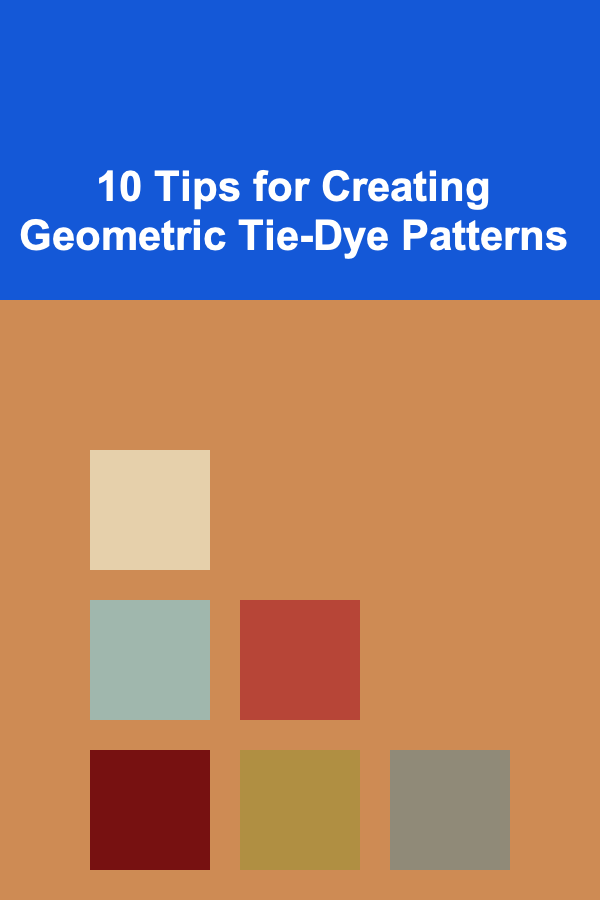
10 Tips for Creating Geometric Tie-Dye Patterns
ebook include PDF & Audio bundle (Micro Guide)
$12.99$7.99
Limited Time Offer! Order within the next:

Tie-dyeing is a creative and vibrant way to add color and texture to fabric. While traditional tie-dye typically uses random swirls and color mixes, geometric tie-dye is a more structured and intentional approach that involves creating sharp, symmetrical patterns. These geometric designs can be stunning and eye-catching, making them a popular choice for both clothing and home décor projects.
In this article, we will explore 10 tips for creating beautiful geometric tie-dye patterns. Whether you're new to tie-dye or have some experience, these tips will help you master the art of geometric design.
Understand the Basics of Tie-Dye
Before diving into geometric tie-dye patterns, it's important to have a basic understanding of how tie-dye works. Tie-dye involves applying dye to fabric that has been folded or twisted in various ways. The fabric is then bound with rubber bands to secure it in place while the dye is applied.
Geometric tie-dye requires a more careful and intentional folding process to ensure that the dye creates crisp, sharp shapes. Some basic folding techniques, such as accordion folds, spiral folds, or pleating, can be adapted to create geometric designs. It's essential to have the right fabric and tools to get started.
Essential Materials for Geometric Tie-Dye:
- White cotton fabric (such as T-shirts or canvas)
- Tie-dye kit or fabric dye
- Rubber bands
- Plastic squeeze bottles or spray bottles for dye
- Plastic tablecloth or plastic bags to protect surfaces
- Plastic gloves
- Plastic or rubber containers for soaking fabric
- Plastic bags or plastic wrap for wrapping the dyed fabric
Choose the Right Fabric
For geometric tie-dye, the fabric you choose is crucial. Cotton is the most popular fabric for tie-dye because it absorbs the dye well, but you can also experiment with other natural fabrics like linen or hemp. The fabric should be pre-washed to remove any chemicals or finishes that might interfere with the dye.
It's also important to choose fabric that has enough surface area to showcase the geometric design you plan to create. T-shirts, bandanas, pillowcases, and canvas bags are excellent options for beginners.
Master the Fold
The most important step in creating a geometric tie-dye pattern is mastering the fold. Different folding techniques result in different geometric shapes. Below are some common folding methods used to create geometric patterns:
a. Accordion Fold
For this fold, you create evenly spaced accordion-style pleats across the fabric. Once the pleats are formed, secure the fabric with rubber bands. This method is perfect for creating square or rectangular patterns.
b. Fan Fold
This fold creates a fan-like effect by folding the fabric in a series of diagonal pleats. This technique is ideal for creating triangular or diamond shapes.
c. Radial Fold
This technique involves folding the fabric like a pizza slice or a wedge. The result is a pattern that radiates out from the center, creating a circular, pie-like design.
d. Shibori Folds
Shibori is a Japanese tie-dye technique that involves folding, twisting, and binding the fabric in intricate ways. This can produce geometric patterns such as squares, circles, or even hexagons.
Mastering these folds is key to creating precise and clean geometric designs. Practice different folding techniques to see how they affect the final pattern.
Plan Your Design
Geometric tie-dye requires planning ahead. Unlike traditional tie-dye, where the design is more spontaneous, geometric tie-dye is about symmetry and balance. Before you start, think about the shapes you want to create and how they will be arranged on the fabric.
Consider whether you want to create a repeating pattern, such as a grid of squares or diamonds, or a more centralized design like a radial pattern. Sketch out your design on paper before starting to help visualize how the colors and folds will work together.
Design Ideas:
- Concentric Circles: Create circles within circles by folding the fabric radially and dyeing each section a different color.
- Stripes: Use accordion folds to create parallel lines of color across the fabric.
- Diamonds: A combination of fan folds and radial folds can create beautiful diamond patterns.
- Hexagons: Shibori folds can be used to form intricate hexagonal shapes.
Use Multiple Colors Strategically
One of the best ways to enhance your geometric tie-dye design is by using multiple colors. However, when working with geometric patterns, it's important to use colors strategically to maintain the sharpness of the design.
Tips for Using Multiple Colors:
- Limit the Color Palette: Choose 2-4 colors for a more cohesive look. Using too many colors can overwhelm the design.
- Use Contrasting Colors: To make the geometric shapes pop, choose contrasting colors that stand out against each other, such as blue and orange or red and yellow.
- Avoid Color Bleeding: To prevent colors from bleeding into each other, make sure to carefully control the application of dye and use rubber bands to secure the fabric tightly.
- Blend Colors: For a softer, blended effect within your geometric shapes, apply dye in layers, allowing the colors to gradually merge together.
Be Precise with Dye Application
In geometric tie-dye, precision is key to achieving clean and sharp lines between colors. Whether you're applying dye with squeeze bottles or spray bottles, make sure to control the dye carefully. Apply the dye to the areas you want it to go, and avoid oversaturating the fabric.
Tips for Precise Dyeing:
- Start with Lighter Colors: Begin with lighter colors and work your way to darker shades. This helps prevent darker colors from overwhelming the lighter ones.
- Apply Dye to Specific Sections: Use squeeze bottles to target specific areas of the fabric. For example, you can dye one section of the fabric red, while leaving another section untouched until you're ready to apply a different color.
- Work in Layers: If you're using multiple colors, apply one layer of dye at a time, allowing it to set before applying the next color.
Use Rubber Bands to Secure the Fabric
Rubber bands are essential for holding the fabric in place while you apply dye. In geometric tie-dye, rubber bands help maintain the integrity of the folds and prevent colors from bleeding into each other.
Tips for Using Rubber Bands:
- Tightly Secure the Fabric: Ensure that the rubber bands are tight enough to hold the fabric in place but not so tight that they squeeze the fabric out of shape.
- Section the Fabric: Use multiple rubber bands to create sections of the fabric that will each be dyed a different color. This will help you control where the dye goes and prevent unwanted color mixing.
- Create Symmetry: When using multiple rubber bands, try to space them evenly to maintain symmetry in the design.
Wrap the Fabric After Dyeing
Once you've applied the dye, it's important to wrap the fabric to allow the dye to set properly. Wrapping the fabric also helps keep the colors from bleeding into unwanted areas.
How to Wrap the Fabric:
- Plastic Wrap: After applying the dye, wrap the fabric in plastic wrap or a plastic bag to hold the dye in place and prevent it from drying out too quickly.
- Let it Set: Leave the fabric wrapped for 6-8 hours, or as instructed by your dye kit, to ensure that the colors fully set.
- Avoid Unwrapping Too Early: Don't be tempted to unwrap the fabric too soon. The longer you let the dye set, the more vibrant and defined your geometric pattern will be.
Rinse and Dry the Fabric Properly
Once the dye has set, it's time to rinse the fabric. Rinsing helps remove excess dye and ensures that the colors remain vibrant.
How to Rinse and Dry:
- Rinse in Cold Water: Rinse the fabric in cold water to remove excess dye. Be gentle to avoid disturbing the pattern.
- Use Mild Detergent: After rinsing, wash the fabric with mild detergent to remove any remaining dye.
- Hang to Dry: Once the fabric is clean, hang it up to dry. Avoid direct sunlight, as it can fade the colors. Allow the fabric to dry completely before using it.
Experiment with Advanced Techniques
As you become more comfortable with geometric tie-dye, don't be afraid to experiment with more advanced techniques. You can create complex patterns by combining different folding methods or by applying dye in more intricate ways.
Advanced Techniques:
- Tied and Dyed Layers: Create intricate designs by layering multiple folds and securing them with rubber bands. Each layer will create a different geometric shape that intersects with others.
- Resist Dyeing: Use techniques like wax resist or string resist to block certain areas from absorbing dye, creating sharp geometric lines or shapes.
- Reverse Dyeing: For a more dramatic effect, you can use bleach to reverse the dye in certain sections, creating geometric designs with light and dark contrast.
Experimenting with these techniques will allow you to push the boundaries of your geometric tie-dye designs and create truly unique pieces.
Conclusion
Creating geometric tie-dye patterns is a fun and rewarding process that allows you to experiment with color and design in a structured way. By following these 10 tips, you'll be able to master the art of geometric tie-dye and create stunning, symmetrical patterns that will stand out. Remember to start with simple folds and gradually challenge yourself with more complex designs as you gain confidence. With practice, you'll be able to create beautiful geometric tie-dye patterns that are both artistic and visually striking.
Reading More From Our Other Websites
- [Home Party Planning 101] How to Identify the Best Party Planners for Your Home Celebration
- [Home Budget Decorating 101] How to Create a Stunning DIY Macrame Wall Hanging on a Shoestring Budget
- [Beachcombing Tip 101] Treasure on the Tide: 10 Unexpected Gems Found While Beachcombing
- [Toy Making Tip 101] Weekend Workshop: Building Perfect Playthings with Kids
- [Personal Care Tips 101] How to Use Conditioner for a Relaxing and Pampering Hair Care Routine
- [Home Soundproofing 101] How to Achieve Maximum Soundproofing in a Small Apartment
- [Home Party Planning 101] How to Create a Fun and Engaging Themed Photo Booth for Your Party
- [Home Staging 101] How to Stage a Small Home: Maximizing Space and Style
- [Personal Care Tips 101] How to Practice Mindfulness in Your Daily Life
- [Personal Care Tips 101] How to Incorporate Natural Personal Care Products into Your Daily Routine

How to Create a Stylish Home Bar Without Overspending
Read More
Why You Need a Dedicated Area for Pet Supplies
Read More
The Step-by-Step Guide to Fly Fishing
Read More
How to Invest in Your 401(k) or IRA
Read More
How to Plan a Bikepacking Trip on a Budget
Read More
10 Tips for Tax Consultants Networking with Financial Advisors
Read MoreOther Products

How to Create a Stylish Home Bar Without Overspending
Read More
Why You Need a Dedicated Area for Pet Supplies
Read More
The Step-by-Step Guide to Fly Fishing
Read More
How to Invest in Your 401(k) or IRA
Read More
How to Plan a Bikepacking Trip on a Budget
Read More